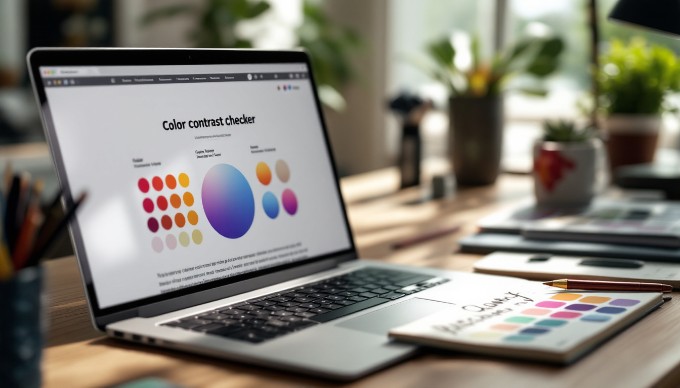Reduce costs by 30-50% for design.
Understanding contrast web design for effective user experience
What is contrast web design
In the dynamic world of digital aesthetics, contrast web design stands out as a key strategy, shaping how users interact with online content. It’s defined as the skillful use of opposing colors, shapes, and sizes to create visual distinction, enhancing the user interface by making navigation intuitive and engaging. This approach not only captures attention but also establishes a clear visual hierarchy, guiding users smoothly through a webpage’s content. By mastering the nuances of contrast web design, businesses can significantly boost user experience, ensuring that crucial information is highlighted and visitors remain engaged. Let’s explore how this powerful design principle can transform your digital presence and drive success.

The psychology behind contrast in design
Understanding the psychology behind contrast in design can greatly enhance a website’s effectiveness. Contrast web design is more than just aesthetics; it’s a powerful tool that influences user perception, emotional responses, and accessibility.
Color contrast plays a pivotal role in how users perceive information on a webpage. When colors are strategically contrasted, they highlight important elements, guide the viewer’s attention, and create visual interest. This leads to a more engaging experience, where key calls-to-action or information stand out clearly.
Emotional responses to contrast are another important factor. Different contrast levels can evoke various emotions and set the tone of a website. For example:
- High contrast designs convey energy and urgency, making them ideal for dynamic brands or promotional campaigns.
- Low contrast designs create a relaxed and soothing atmosphere, perfect for wellness or lifestyle brands.
The impact of contrast on readability and accessibility is vital. Proper contrast ensures text is legible, essential for all users, including those with visual impairments. Effective contrast web design should:
- Enhance readability by ensuring sufficient contrast between text and background colors
- Improve accessibility by adhering to Web Content Accessibility Guidelines (WCAG), which recommend specific contrast ratios for text and images
By thoughtfully applying contrast in web design, you can create a more inclusive and user-friendly experience that resonates emotionally with your audience while ensuring important information is communicated clearly.
Expert graphic design services to elevate your brand. Book a call
Types of contrast in web design
Contrast in web design is crucial for creating visually appealing and user-friendly interfaces. By understanding different types of contrast, designers can enhance the usability and aesthetic of a website. Here are some key types of contrast to consider:
Color contrast is perhaps the most recognized form of contrast in web design. It involves using different colors to make elements stand out. Effective color contrast not only improves readability but also guides users’ attention to critical areas of the page. High color contrast between text and background ensures content is easily legible.
Size contrast is another important aspect of contrast web design. By varying the size of elements, designers can establish a visual hierarchy that helps users understand the importance of different components. Larger elements naturally draw more attention and can be used to highlight key messages or calls to action.
Shape contrast adds visual interest and can be used to differentiate elements. While most web elements are rectangular, incorporating different shapes can make certain sections stand out. For instance, using circular buttons amidst rectangular ones can create a focal point and encourage interaction.
Texture contrast involves using different textures to create depth and dimension on a webpage. This type of contrast can make a design more engaging and tactile. Consider these ways to incorporate texture contrast:
- Use subtle patterns in the background to add interest without overwhelming the content
- Apply textures to buttons or banners to make them stand out
- Contrast smooth and rough textures to guide the user’s eye through the page
Incorporating these types of contrast thoughtfully can significantly enhance the effectiveness of contrast web design, ensuring a website is both attractive and easy to navigate.
Best practices for implementing contrast web design
Implementing effective contrast web design involves a strategic approach to ensure both visual appeal and functionality. By carefully selecting color combinations and using contrast to guide user attention, you can create a website that is both attractive and easy to navigate.
Choosing the right color combinations
Selecting the right colors is crucial for effective contrast web design. The goal is to create a harmonious yet striking palette that enhances readability and accessibility. Here are some tips for choosing color combinations:
- Opt for high-contrast pairs like black and white for text and background to ensure readability
- Consider using complementary colors to achieve a vibrant look that captures attention
- Use muted tones to balance bright colors, preventing the design from becoming overwhelming
- Test color combinations for accessibility to ensure that all users, including those with visual impairments, can easily navigate your site
Using contrast to guide user attention
Contrast is an effective tool for directing user focus to key elements on a webpage. By strategically using contrast, you can highlight important information and guide users through your content. Consider these practices:
- Use bold colors for call-to-action buttons to make them stand out
- Implement contrasting colors to differentiate between primary and secondary elements
- Employ varying text sizes and weights to draw attention to headings and important content
Balancing contrast for aesthetics and usability
While contrast is essential for drawing attention, it’s important to maintain a balance to ensure both aesthetics and usability. Overuse of contrast can lead to a cluttered and confusing design. Here are some guidelines to achieve this balance:
- Ensure that contrast enhances readability without straining the eyes
- Maintain a consistent contrast theme throughout the site for a cohesive look
- Regularly test your design on different devices to ensure it remains user-friendly
By following these best practices, you can effectively utilize contrast web design to create an engaging and accessible website. This approach not only improves user experience but also enhances the overall aesthetic appeal of your site.
Tools and resources for testing contrast
When working on contrast web design, ensuring that your designs are accessible and visually appealing is crucial. There are several tools and resources available to help you test and improve color contrast in your web designs.
Color contrast checkers
These online tools are essential for evaluating the contrast ratio between text and background colors. They help ensure compliance with accessibility standards, making your website more inclusive. Some popular options include:
- WebAIM Contrast Checker provides a straightforward interface to test color combinations and see if they meet WCAG guidelines
- Contrast Ratio by Lea Verou offers a simple slider interface to adjust colors and instantly see the contrast ratio
- Tanaguru Contrast Finder helps identify color pairings that comply with accessibility standards, especially useful for complex designs
Design software with contrast tools
Many design software programs incorporate features that assist with contrast testing, streamlining the design process. These tools can help you make adjustments directly within your design environment:
- Adobe XD and Photoshop both offer plugins and built-in features to check color contrast as you design
- Sketch has several plugins available that allow designers to test contrast ratios without leaving the app
- Figma provides access to various plugins that help in checking and adjusting color contrast effectively
Accessibility guidelines and standards
Following established guidelines ensures that your contrast web design is accessible to all users. Key guidelines to consider include:
- WCAG (Web Content Accessibility Guidelines) offers a comprehensive framework for creating accessible web content, including specific contrast ratio requirements
- ADA (Americans with Disabilities Act) Standards, while more general, adherence to these standards can help ensure your website is accessible to users with disabilities
- ISO Standards for Accessibility provides additional international guidelines that can be beneficial for global web design projects
By leveraging these tools and resources, you can enhance the accessibility and visual appeal of your website, ensuring your contrast web design meets the needs of all users.

Conclusion and future of contrast web design
In conclusion, the significance of contrast web design cannot be overstated in the evolving landscape of digital aesthetics and functionality. As explored, contrast plays a pivotal role in enhancing user experience by ensuring content is accessible and visually engaging. By employing effective contrast, designers can guide users’ attention, improve readability, and create a more intuitive navigation experience. Emerging trends in web design, such as dark mode and minimalist aesthetics, further underscore the necessity of strategic contrast to maintain visual interest and accessibility across diverse platforms.
As the digital world continues to advance, integrating contrast effectively remains crucial. It empowers designers to craft websites that not only captivate but also serve users’ needs efficiently. We encourage you to delve deeper into the principles of contrast web design and consider implementing these insights into your projects. By prioritizing contrast, you can enhance the overall user experience, ensuring your website stands out in a competitive digital environment. Explore, experiment, and elevate your design strategies to harness the full potential of contrast in web design.
Boost Engagement with Conversion-Driven Design
Enhance usability with optimized designs that convert users into customers.
Learn More